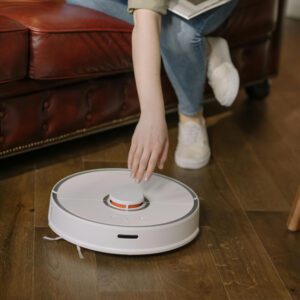How Do I Choose a Robot Vacuum? A Step-by-Step Guide for U.S. Homes
So, you’re ready to ditch the manual vacuuming and let a robot handle the dirty work. But with dozens of models flooding the market, figuring out how to choose a robot vacuum can feel like navigating a maze. This guide cuts through the noise and breaks down exactly what matters for American households—whether you’re tackling pet hair in Texas, hardwood floors in New York, or multi-level homes in California.
Start With Your Home’s “Personality”
Floor Types: Carpets, Hardwood, or Both?
Your floors dictate your robot vacuum’s must-have features:
-
Thick carpets? Prioritize motorized brushes and 2,500+ Pa suction power to dig deep into fibers.
-
Hardwood or tile? Opt for rubberized brushes to prevent scratches and models with auto-suction adjustment for debris like cereal crumbs.
-
Mixed flooring? Look for vacuums that sense floor changes and adapt suction/brush speed instantly.
Obstacles & Layout Challenges
-
Cluttered spaces? Advanced object detection (like cameras or lasers) helps avoid shoe piles, cords, or rogue LEGO bricks.
-
Furniture-heavy rooms? A slim design (under 3” tall) ensures cleaning under couches and beds.
-
Multi-story homes? Choose vacuums that save multiple floor maps so you’re not re-mapping every time it moves upstairs.
The Cleaning Tech That Actually Matters
Suction Power: Not Just a Numbers Game
While higher Pascals (Pa) mean stronger suction, balance power with battery life and noise:
-
1,500–2,500 Pa: Ideal for daily cleaning on hard floors or low-pile carpets.
-
2,500+ Pa: Necessary for deep-cleaning carpets or homes with shedding pets.
-
Pro Tip: Adjustable suction modes let you save battery for quick cleanups and crank it up for weekend deep cleans.
Brush Systems: The Unsung Heroes
-
Roller + Side Brushes: A combo brush system grabs debris from corners (side brushes) and lifts dirt from carpets (main roller).
-
Tangle-Free Tech: Rubber rollers or anti-wrap designs are lifesavers for pet owners or long-haired households.
Filters: Breathe Easy
-
HEPA Filters: Traps 99.97% of allergens (dust mites, pollen)—non-negotiable if you have allergies.
-
Washable vs. Replaceable: Washable filters save money long-term but require monthly rinsing.
Battery Life: Will It Finish the Job?
Runtime vs. Recharge Time
-
60–90 Minutes: Covers apartments or small homes (<1,500 sq. ft).
-
120+ Minutes: Necessary for large homes, but verify if it auto-resumes cleaning after recharging.
-
Fast Charging: Some models recharge fully in 2 hours vs. 4+ hours for budget picks.
Multi-Level Homes Hack
If your vacuum can’t save multiple maps, keep a second charging dock on another floor to avoid lugging it upstairs.
Navigation: From “Dumb” to Genius
Basic vs. Smart Navigation
-
Random Bounce (Budget Models): Works for studio apartments but misses spots and takes longer.
-
LIDAR Mapping: Uses lasers to create precise floor plans—ideal for complex layouts.
-
Camera-Based: Recognizes furniture and avoids obstacles in real time (e.g., nightlights or dark rugs).
“No-Go Zones” Are a Game-Changer
Use your smartphone app to block off areas like:
-
Pet food bowls
-
Playrooms with small toys
-
Delicate rug fringes
Smart Features Worth the Hype (and Ones to Skip)
Must-Haves:
-
Voice Control: “Alexa, start vacuuming the kitchen” beats digging for your phone.
-
App Scheduling: Set it to clean while you’re at work or synced with your thermostat’ “away” mode.
-
Auto-Emptying Bases: If you hate emptying dustbins, these docks hold weeks of debris (but add $200+ to the price).
Skip These Unless You Need Them:
-
Mop Attachments: Most hybrid models are mediocre at mopping—better to buy a dedicated robot mop later.
-
Ultra-Fancy Apps: Real-time video tracking drains battery and feels gimmicky for most users.
Noise Levels: The Underrated Dealbreaker
Robot vacuums range from “background hum” to “mini helicopter”:
-
<60 dB: Quiet enough for Zoom calls or naptime (look for “quiet mode” labels).
-
65–70 dB: Standard for powerful suction—avoid if noise sensitivity is a concern.
Budgeting: What’s the Sweet Spot?
Entry-Level (200–400):
-
Basic navigation, shorter battery life.
-
Best for: Small spaces, hard floors, or occasional use.
Mid-Range (400–700):
-
LIDAR navigation, stronger suction, app controls.
-
Best for: Pet owners or homes with mixed flooring.
Premium ($700+):
-
Self-emptying bases, multi-floor mapping.
-
Best for: Large homes or hands-off users.
3 Pitfalls to Avoid
-
Ignoring Maintenance Costs: Replacement filters (15–30/year) and brushes add up.
-
Overpaying for Unused Features: Do you really need that Instagram-worthy app?
-
Skipping Reviews: Check Reddit or Amazon verified reviews for real-world performance hiccups (e.g., “gets stuck on lamp cords daily”).
Final Checklist Before Buying
-
✅ Measured under-furniture clearances
-
✅ Compared brush types to your flooring
-
✅ Checked warranty (1+ years) and U.S. customer support
-
✅ Tested retailer’s return policy (30-day windows are ideal)
By matching your home’s quirks to the right features, choosing a robot vacuum becomes less about tech jargon and more about what actually simplifies your life. Whether you’re battling tumbleweeds of dog hair or just want to spend less time cleaning, the perfect model is out there—no hype required. Now, go reclaim those hours you’ve been spending on vacuum duty!



